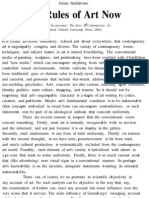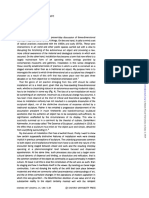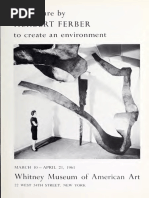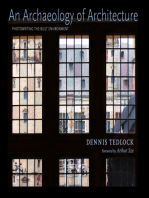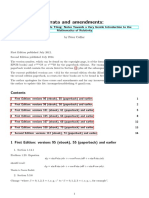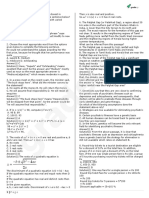Anish Kapoor: P A R K e T T 6 9 - 2 0 0 4
Anish Kapoor: P A R K e T T 6 9 - 2 0 0 4
Uploaded by
Guillem Alventosa TalamantesCopyright:
Available Formats
Anish Kapoor: P A R K e T T 6 9 - 2 0 0 4
Anish Kapoor: P A R K e T T 6 9 - 2 0 0 4
Uploaded by
Guillem Alventosa TalamantesOriginal Title
Copyright
Available Formats
Share this document
Did you find this document useful?
Is this content inappropriate?
Copyright:
Available Formats
Anish Kapoor: P A R K e T T 6 9 - 2 0 0 4
Anish Kapoor: P A R K e T T 6 9 - 2 0 0 4
Uploaded by
Guillem Alventosa TalamantesCopyright:
Available Formats
ANISH KAPOOR
Parket t 69 2004
We have become accustomed to the fact that sculp-
ture has climbed off its pedestal and spread about.
Decades ago, Land Art appropriated the full-scale
landscape and the long shot (for which reason it also
insisted on the aerial view). Today we look at sculp-
ture neither with the eyes of Alberto Giacometti, who
you might say devoured it from the depths of the
gaze, nor with those of David Smith, who set its parts
into dancing motion. Sculpture has long since taken
a firm stand with a spectrum ranging from Richard
Serras freestanding walls of steel to Dan Flavins
vibrant, colored stelae. The contrast between tons of
heavy steel and luminous gases, between material
density and optical wavelengths not only fuels the de-
bate on the essence of sculpture versus image; it also
recalls controversies about the nature of light and
the mechanics of perception.
Around 1980, Anish Kapoor showed sculptures
that produced a strange effect due to the texture of
their colored surfaces. In the years that followed, he
rounded their forms or carved hollows into stone.
Sometimes polished to a high gloss or dyed a strong
color, they absorb the light or refract it in diagram-
matic form. Funnel-shaped recesses in stones, walls,
K U R T W. F O R S T E R
A Word i n
t he Gi ant s Ear
K U R T W. F O R S T E R , holder of the Gropius chair at the
Bauhaus University of Weimar, is director of next years Archi-
tecture Biennale in Venice which will be dedicated to the theme
of Metamorphoses.
121 PA R K E T T 69 2 0 03
An i s h Ka p o o r
ANISH KAPOOR, UNTITLED, 2001, marbl e, 64
1
/2 x 88
5
/8 x 49
5
/8,
Barbara Gl adstone Gal l er y, New York /
OHNE TITEL, Marmor, 164 x 225,2 x 126,1 cm.
An i s h Ka p o o r
122
or even floors pierce the conventional limits of a
room and reach out into unforeseeable territories.
The gray of a curved recess and reflections on shiny
steel yield an optical ambivalence that momentarily
generates the same impression achieved by Jean Coc-
teau in his film Orphe (1950) when his figures enter
and exit through the quicksilvery surface of mirrors.
However, since Kapoors enigmatic hollows share none
of Cocteaus obtrusive suggestiveness, they refer
much more intensely to the sculptures themselves.
The emptiness around things and the conceivable
depth within them collide on reflecting surfaces, be-
siege the eyes and provoke a disturbing unease, as
Kapoor explains in conversation with Homi Bhabha.
1)
He sees his stones as a substance enriched by time,
whose history may be revealed in the process of
sculpting.
2)
Kapoors surfaces appear unstable; their convex
curves or concave funnels make the sculpture look as
if it were collapsing in on itself. The immaculate
sheen of the steel cubes (UNTITLED, 1997) face view-
ers like upended sarcophagi with imploding surfaces
that elude our visual grasp. Spontaneously we reach
out in the vain attempt to rescue them from sinking,
but the sculptural shape is in the process of vanish-
ing into an optical maelstrom, as if sucked out of its
own body and into a moving exterior. As Homi
Bhabha describes it, A sudden disappearance of sur-
face in a deep, dark hole literally cuts the ground
from under our feet.
3)
The extraordinary suction that emanates from
these sculptures and seems almost to devour them is
not a consequence of exceptional optical effects that
occur only on certain surfaces. Kapoors objects
this dispassionate designation is perhaps best quali-
fied to capture their ambivalence in a single word
paradoxically find themselves in the act of self-con-
sumption. They articulate the idea of their own
depth, even where it remains invisible, but also the
idea of their own time. It simply takes time to expose
oneself to their impact and nothing much may actu-
ally happen. Very little does, in fact, happen exter-
nally, yet the longer we look, the more we learn from
the sculpture. On the other hand, by showing itself
to be curiously curved in space and time, it denies
us some of the ground upon which we presume to be
standing so firmly. The curvatureof surfaces, of re-
flections, of colorscauses a sense of suspension
that is capable of disturbing and even frightening us.
We are certainly not off the mark in assuming that
Kapoors objects create a relation between volume
and surface far different from anything we ever
learned in school. Instead of subsuming a sculptures
volume to its image, or dulling its body into the ap-
pearance of a mere shape, he sets the two into an
antagonistic relationship. His objects optically dis-
rupt the relation that furnishes proof of substance
and shape, namely the relation of surface to body.
Kapoor effectively and literally undercuts the differ-
ence between what we explore only with our eyes and
what we can grasp only through the physical sense of
touch, that is, the hypothesis that sculpture belongs
entirely to the world of the viewer. With utmost pre-
cision, the continuously curving surfaces of the
sculptures transform the traditional relationship of
surface and body into a continuum. Their juxtaposi-
tion gives rise to a differential linkage. For this rea-
son, their further use should rely increasingly on
computer programs capable of calculating an entire
bundle of differing algorithms and their interaction.
Cecil Balmond, director of the London firm Ove
Arupconstruction laboratory of contemporary
architecture par excellenceput the rule to the test
with his models for calculating Kapoors towering
sculptures.
In the year 2000, Kapoor took a giant step when
he installed a work in a former flourmill in the port
of Newcastle-upon-Tyne: TARATANTARAa name
like a flourishwas hung in the hollowed-out shell
of a silo. Richard Deacon described it as follows:
The tube of red vinyl stretched between the two re-
maining standing walls replaced the missing end
walls and seemingly converted the building into a
block with a hole through it. From the outside, this
was fairly simple; one saw the stretched red fabric
and anticipated or imagined the mechanics of the in-
stallation. Although certainly the continuity of sur-
face between the two endsthe effect of a folding of
the outside into a vortex that swept through the
buildingcaused some complications, and the glis-
tening, vibrant surface of the vinyl gleamed with an
awesome intensity.
4)
We are overwhelmed not only
123
ANISH KAPOOR, UNTITLED, 2003, steel and water, dimensions variabl e, exhibition Anish Kapoor, National Archaeol ogical Museum,
Napl es, 25 October 2003 12 Januar y 2004 / OHNE TITEL, Stahl und Wasser, Grsse variabel .
(PHOTO: PEPPE AVALLONE, NAPOLI)
An i s h Ka p o o r
124
ANISH KAPOOR, DESCENT INTO LIMBO, 1992, concrete
and stucco, 19
8
/12 x 19
8
/12 x 19
8
/12, Documenta IX, Kassel ,
1992, exterior view and interior detail /
EINSTIEG ZUR VORHLLE, Beton und Stuck, 6 x 6 x 6 m,
Aussenansicht und Innenansicht.
(PHOTO: DIRK DE NEEF, GHENT)
125
by the dimensions, corresponding approximately to
a ten-storey building, but above all by the link be-
tween inside and outside in the form of a fantastically
extended tunnel of deep red plastic fabric. Kapoor
was again testing the curious power of sculpture that
consumes its own volume as well as the room in
which it is housedbut this time in gigantic scale. In
his own words, The foreshortening of the building
from the outside as one looks through the form is to
me, surprising. The building appears to be only half
as long as the impression one had of it from the ex-
ternal structure. From the outside of the building,
only the inside of the form is visible. From the inside
of the building, only the outside of the form is visi-
ble. It is as if the space inside the building had sud-
denly expanded and what was a hole became a form
Inside and outside seem to be turning into each
other.
5)
The effect of this gigantic sculpture also rests on
the relation of closeness and distance, depending on
the position of the viewer and the texture of the ma-
terial, whose parabolic extension, colors, and effects
even managed to surprise Kapoor himself. The sur-
face properties of his materials proved in retrospect
to be characteristic and not accidental. As such, they
inspired work increasingly removed from the artists
earlier oeuvre in scale and material. Recently he has
begun working with materials that were long alien to
sculpture, and in places that are already dominated
by mighty buildings.
A high point in Kapoorss efforts to exceed even
the architecture of his sites was reached by the recent
installation at Londons Tate Modern, in which trum-
pet-shaped funnels threatened almost to burst the
immense hall. Last years MARSYAS installation
6)
is a
spatial demonstration of what one might call a visual
droning. Created as a kind of two-ended trumpet
with a cupola-like opening, it floated above the heads
of museum visitors thanks to the resistance of the
synthetic material that Kapoor used. The evolution
of the largest project to date, whose complexity ut-
terly eclipses the experiment in Newcastle, shows a
fascinating combination of visionary ideacaptured
in small sketches and modelsand state-of-the-art,
hi-tech engineering. Structural engineer Cecil Bal-
mond tuned himself into Kapoors agenda and in his
catalogue essay Skinning the Imagination,
7)
he dis-
closes how a highly sophisticated combination of
pull, elasticity, and load made it possible to turn forty
tons of steel and fabric into a giant sculpture. But
MARSYAS does share one thing with the installation
in Newcastle: both devour the architecture, calling
into question the solid contours and encompassing
spaces in the process. What once appeared as a fath-
omless, wavering field in the depths of the stone,
hard as it may be, now deprives viewers of access as
infinitely stretching, bending funnels and tunnels of
colored fabric. It is inconceivable that architecture,
with and of itself, could possibly ever bring about
what Kapoor has achieved in his installations: turning
space inside out, folding it in on itself and hollowing
it out. Such an enterprise requires an imaginative
approach of the kind manifested in recent astro-
physicsa field concerned with the inaccessibly
distant and inconceivably old time-spaces of the
universeby confronting our ordinary three-dimen-
sional world with the idea of the saddle-shaped
spaces of string theory. Their visual representation,
as also used by Stephen Hawking,
8)
shows impressive
affinities with the spatial funnels that Kapoor aspires
to. We find comfort in discovering at least one bit of
common ground between the incomprehensible, in-
soluble enigma of Kapoors works and the necessity
of imagining things we shall never be able to see.
(Translation: Catherine Schelbert)
1) Anish Kapoor, catalogue of the exhibition at the Hayward
Gallery, London, 1998, with essays by Homi K. Bhabha and Pier
Luigi Tazzi (Berkeley/Los Angeles/London: University of Cali-
fornia Press, 1998), p. 18: in that narrow passage [between
the mirrors], paradoxically there is a restlessness, an unease
2) Ibid., p. 27: There is a history in the stone and through the
simple device of excavating the stone its just as if a whole nar-
rative sequence is suddenly there
3) Ibid., p. 24.
4) Richard Deacon, Baltic Anish, in Anish Kapoor, TARATAN-
TARA (Barcelona: ACTAR Editorial, 2000), s.p.
5) Ibid., Anish Kapoor in conversation with Sune Nordgren, s.p.
6) See Anish Kapoor, Marsyas, exh. cat. (London: Tate Publish-
ing, 2002).
7) Cecil Balmond, Skinning the Imagination, in Anish Kapoor,
Marsyas, ibid., pp. 6669.
8) Cf. Stephen Hawking, The Universe in a Nutshell (London:
Bantam Press, 2002).
An i s h Ka p o o r
You might also like
- Paul OnNeill & Claire Doherty (Eds) - Locating The Producers. Public Art (Book)Document217 pagesPaul OnNeill & Claire Doherty (Eds) - Locating The Producers. Public Art (Book)Ursache CristianaNo ratings yet
- Martin Beck Last NightDocument141 pagesMartin Beck Last NightArla RamlaNo ratings yet
- Concept PaperDocument5 pagesConcept PaperPrincess Marie JuanNo ratings yet
- The Interpretation of The Glass DreamDocument25 pagesThe Interpretation of The Glass Dreamweareyoung5833No ratings yet
- Agesander Vs Burghers of Calais 2Document4 pagesAgesander Vs Burghers of Calais 2Kennedy Cook100% (1)
- Light & Architecture - Cesar PortelaDocument4 pagesLight & Architecture - Cesar PortelaCristina MunteanuNo ratings yet
- Rules of Art NowDocument9 pagesRules of Art NowDr. Teresa M. TiptonNo ratings yet
- Maintenance Planning, Coordination, Scheduling and ExecutionDocument19 pagesMaintenance Planning, Coordination, Scheduling and ExecutionBayu Prayoga Part II100% (2)
- MK Architecture & Design PortfolioDocument15 pagesMK Architecture & Design PortfolioKenzieKeenanNo ratings yet
- IMP Approaching Architecture - The Cases of Richard Serra and Michael AsherDocument13 pagesIMP Approaching Architecture - The Cases of Richard Serra and Michael AsherToby J Lloyd-JonesNo ratings yet
- Miwon Kwon On Jessica StockholderDocument13 pagesMiwon Kwon On Jessica StockholderazurekittyNo ratings yet
- The Importance of Colour On Ancient MarbDocument32 pagesThe Importance of Colour On Ancient MarbMarijaNo ratings yet
- Anish KapoorDocument2 pagesAnish KapoorNiamh ConneelyNo ratings yet
- Jitish KallatDocument50 pagesJitish Kallatadarsh raoNo ratings yet
- Paolo SoleriDocument25 pagesPaolo SoleriK.SRI CHAANTHANANo ratings yet
- Lessons From Il Professore Carlo Scarpa PDFDocument18 pagesLessons From Il Professore Carlo Scarpa PDFIñigo López VeristainNo ratings yet
- 1998threshold DompierreDocument4 pages1998threshold DompierreFalgun HindochaNo ratings yet
- GEC 6 - MODULE - WPS PDF ConvertDocument32 pagesGEC 6 - MODULE - WPS PDF ConvertRene Jay-ar Morante Segundo100% (1)
- Studies in Tectonic Culture The Poetics of Construction in Nineteenth and Twentieth Century ArchitectureDocument4 pagesStudies in Tectonic Culture The Poetics of Construction in Nineteenth and Twentieth Century ArchitectureMarchelia SariNo ratings yet
- Perspectives of New MusicDocument13 pagesPerspectives of New Musicrhyscorr100% (2)
- CAEIRO-EN-Korbicka-1 EDITS DONEDocument14 pagesCAEIRO-EN-Korbicka-1 EDITS DONEMário CaeiroNo ratings yet
- Cultural ContextDocument18 pagesCultural ContextMasson KarrNo ratings yet
- Bailey D Art:Archaeology:ArtDocument20 pagesBailey D Art:Archaeology:ArtNastassjaSimeNo ratings yet
- Module 8 Art App 103Document13 pagesModule 8 Art App 103Berna QuiambaoNo ratings yet
- Sculpturalism and ArchitectureDocument6 pagesSculpturalism and ArchitectureIpsita03No ratings yet
- Softsculptureevents - MEKE SKULPTURE VAOOO PDFDocument28 pagesSoftsculptureevents - MEKE SKULPTURE VAOOO PDFadinaNo ratings yet
- Potts 2001Document17 pagesPotts 2001Juan Carlos Camacho MolinaNo ratings yet
- Ross Wolfe, Architecture and Its Image: Or, Must One Visit Architecture To Write About It? (Spring 2014)Document11 pagesRoss Wolfe, Architecture and Its Image: Or, Must One Visit Architecture To Write About It? (Spring 2014)Ross WolfeNo ratings yet
- ULFBA - W 210 - José TeixeiraDocument29 pagesULFBA - W 210 - José TeixeiraFrancisco Cardoso de MenezesNo ratings yet
- Art//Archaeology//Art: Letting-Go Beyond: DatasetDocument23 pagesArt//Archaeology//Art: Letting-Go Beyond: DatasetAndré AraújoNo ratings yet
- Virginio FerrariDocument30 pagesVirginio FerrariThe Renaissance Society0% (1)
- Daniel Buren: From Painting To ArchitectureDocument7 pagesDaniel Buren: From Painting To ArchitectureYasmin ElganimNo ratings yet
- What Is Space in Art? Examples and DefinitionDocument9 pagesWhat Is Space in Art? Examples and DefinitionKatherine Canisguin AlvarecoNo ratings yet
- MIDTERM ART APP (1)Document14 pagesMIDTERM ART APP (1)ain't your saintessNo ratings yet
- Agenda and ErrataDocument7 pagesAgenda and ErrataruiliminorNo ratings yet
- Art+Books: Neo-ArcadiaDocument3 pagesArt+Books: Neo-ArcadiamontalvoartsNo ratings yet
- Shadowrun Hong Kong - Artbook PDFDocument126 pagesShadowrun Hong Kong - Artbook PDFGabriel Apel Fonseca100% (3)
- Sculpture EnvironmentDocument4 pagesSculpture EnvironmentNefertari Juárez AguilarNo ratings yet
- Carlo ScarpaDocument10 pagesCarlo ScarpaNeitherboth75% (4)
- Abstract in Contemporary ArtsDocument14 pagesAbstract in Contemporary ArtsArjay M. LusterioNo ratings yet
- The Art of Invisible CitiesDocument26 pagesThe Art of Invisible CitiesTorran RodgersNo ratings yet
- Diagrams DiariesDocument22 pagesDiagrams Diariesmemet1charum100% (2)
- Unit 4 - Experiencing ArchitectureDocument45 pagesUnit 4 - Experiencing ArchitectureJennifer PaulNo ratings yet
- Virtual EssayDocument20 pagesVirtual Essaytroberts1992No ratings yet
- Rebellon, Daryll S. 'Final Exams'Document3 pagesRebellon, Daryll S. 'Final Exams'Dariru KunNo ratings yet
- Baroque Tendencies IntroDocument30 pagesBaroque Tendencies IntrobblqNo ratings yet
- PollockGravity ArticleDocument25 pagesPollockGravity ArticlealiceNo ratings yet
- Jstor: The Bvrlington MagazineDocument3 pagesJstor: The Bvrlington MagazineUlisesodisseaNo ratings yet
- antonia_hirsch_negative_spaceDocument7 pagesantonia_hirsch_negative_spacePop RalucaNo ratings yet
- Villa SavoyeDocument10 pagesVilla SavoyeNikita SarinNo ratings yet
- Dispense Archeologia Dei Media Parte 1Document75 pagesDispense Archeologia Dei Media Parte 1Filippo FabbriNo ratings yet
- The Concept of Space in Twentieth Century Art: Christopher W. Tyler and Amy IoneDocument13 pagesThe Concept of Space in Twentieth Century Art: Christopher W. Tyler and Amy IoneFelipe PiresNo ratings yet
- 1709 2037 1 PBDocument16 pages1709 2037 1 PBAndreea DalimonNo ratings yet
- Mark Godfrey Simon Starlings Regenerated SculptureDocument5 pagesMark Godfrey Simon Starlings Regenerated SculptureMahan JavadiNo ratings yet
- Why Is It So Hard To Describe Experience JA JB CMDocument20 pagesWhy Is It So Hard To Describe Experience JA JB CMRNo ratings yet
- On the Role of Architectural Criticism TDocument2 pagesOn the Role of Architectural Criticism ThuniatomoumNo ratings yet
- TransparencyDocument2 pagesTransparencyLuis AraújoNo ratings yet
- Leadwork Old and Ornamental and for the most part EnglishFrom EverandLeadwork Old and Ornamental and for the most part EnglishRating: 5 out of 5 stars5/5 (1)
- An Archaeology of Architecture: Photowriting the Built EnvironmentFrom EverandAn Archaeology of Architecture: Photowriting the Built EnvironmentNo ratings yet
- The Angry Brain Neural Correlates of Anger, Angry Rumination and Aggressive PersonalityDocument11 pagesThe Angry Brain Neural Correlates of Anger, Angry Rumination and Aggressive Personalityçiğdem ünsalNo ratings yet
- Motivations For Entrepreneurship-1Document6 pagesMotivations For Entrepreneurship-1gokulnadar88No ratings yet
- Strees ManagmentDocument53 pagesStrees ManagmenttiginjohnNo ratings yet
- Development and Validation of RP HPLC Method For Estimation of Vortioxetine in Bulk and Pharmaceutical Dosage FormDocument15 pagesDevelopment and Validation of RP HPLC Method For Estimation of Vortioxetine in Bulk and Pharmaceutical Dosage FormEditor IJTSRDNo ratings yet
- Introduction To Environmental Engineering Technology LaboratoryDocument9 pagesIntroduction To Environmental Engineering Technology LaboratorySYaz WAniNo ratings yet
- Basics of ENTREPRENEURSHIP PPTSDocument34 pagesBasics of ENTREPRENEURSHIP PPTSAves khanNo ratings yet
- Cruel Angels' Thesis - Trumpet TrioDocument1 pageCruel Angels' Thesis - Trumpet TrioAsierNo ratings yet
- Full Download Numerical and Statistical Methods for Civil Engineering Gujarat Technological University 2017 2nd Edition Ravish R Singh PDF DOCXDocument57 pagesFull Download Numerical and Statistical Methods for Civil Engineering Gujarat Technological University 2017 2nd Edition Ravish R Singh PDF DOCXmajriwng100% (1)
- Advanced Fulfillment: Streamline Fulfillment To Reduce Errors, Generate More Transactions, and Increase ProductivityDocument2 pagesAdvanced Fulfillment: Streamline Fulfillment To Reduce Errors, Generate More Transactions, and Increase ProductivitydianjulianNo ratings yet
- Going Places &poet & PancakesDocument9 pagesGoing Places &poet & PancakesPoorvi GuptaNo ratings yet
- Errata - A Most Incomprehensible ThingDocument16 pagesErrata - A Most Incomprehensible ThingAshish JogNo ratings yet
- Assessment Task 3 - Social Inclusion and Exclusion EssayDocument2 pagesAssessment Task 3 - Social Inclusion and Exclusion Essayohay2691No ratings yet
- Ethics Lesson 1Document8 pagesEthics Lesson 1Lem MasangkayNo ratings yet
- 1984 A StudyDocument15 pages1984 A Studygilmour99No ratings yet
- Loyal Order of Wormwood HowtoDocument13 pagesLoyal Order of Wormwood Howtovince223No ratings yet
- MULTIPLE CHOICE. Choose The One Alternative That Best Completes The Statement or Answers TheDocument13 pagesMULTIPLE CHOICE. Choose The One Alternative That Best Completes The Statement or Answers TheaaxdhpNo ratings yet
- Disney Princess ThesisDocument6 pagesDisney Princess Thesissarahgordonanchorage100% (2)
- Methods of Studying GrowthDocument112 pagesMethods of Studying GrowthEmad Ahmad Anis67% (3)
- Arabic in The Digital AgeDocument23 pagesArabic in The Digital AgeCmatzs RedEagleNo ratings yet
- CS 2014 - Set-1-Watermark - pdf-61 PDFDocument25 pagesCS 2014 - Set-1-Watermark - pdf-61 PDFsaundarya kumarNo ratings yet
- GAP-ANALYSIS-RCY-Resiliency and Well-BeingDocument2 pagesGAP-ANALYSIS-RCY-Resiliency and Well-BeingMichelle BaguioNo ratings yet
- Matrix Lesson PlanDocument18 pagesMatrix Lesson PlanAlanaNo ratings yet
- Access Control MatrixDocument36 pagesAccess Control MatrixvkalhanreddyNo ratings yet
- Elise Maths Unit Plan Number Place ValueDocument4 pagesElise Maths Unit Plan Number Place Valueapi-366807311No ratings yet
- Rizal-Group 3 Integrating ProjectDocument2 pagesRizal-Group 3 Integrating ProjectDaiana M. Molejon100% (1)
- Practice Teaching A Reflective Approach Chap 7 Classroom Observation in Teaching PracticeDocument3 pagesPractice Teaching A Reflective Approach Chap 7 Classroom Observation in Teaching PracticeRaquel M. Mendoza0% (1)
- GC0028 09big Butte Feasibility Report PDFDocument166 pagesGC0028 09big Butte Feasibility Report PDFbayuNo ratings yet






